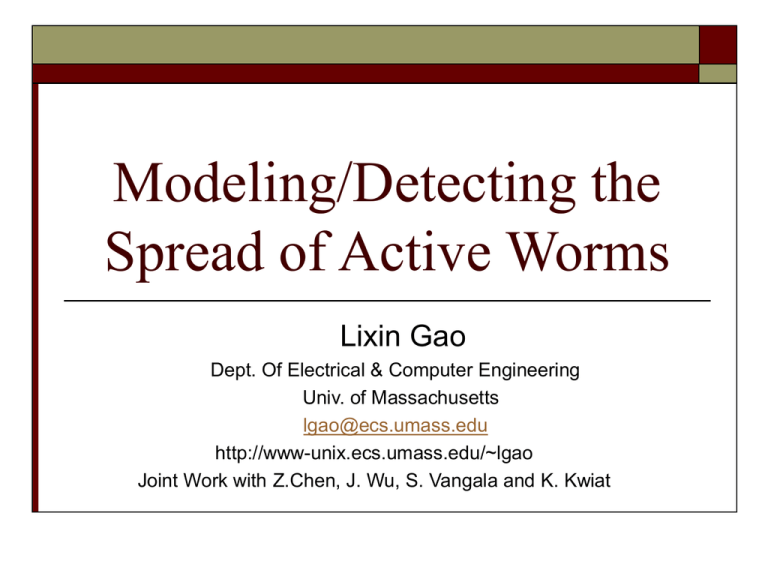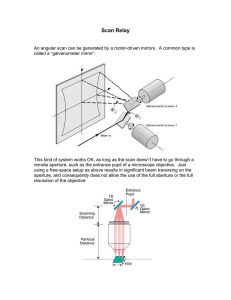Modeling/Detecting the Spread of Active Worms
advertisement

Modeling/Detecting the Spread of Active Worms Lixin Gao Dept. Of Electrical & Computer Engineering Univ. of Massachusetts lgao@ecs.umass.edu http://www-unix.ecs.umass.edu/~lgao Joint Work with Z.Chen, J. Wu, S. Vangala and K. Kwiat Monitoring Architecture Detection Center Traffic Analyzer Traffic Analyzer Black Hole Black Detector Hole Monitoring Component Network Traffic Traffic Analyzer Analyzer Black Detector Hole Black Black Hole Hole Detector Local IDS Local IDS IDS LocalDIMACS Subnet Local Subnet workshop on Large-Scale Internet Attack, Sept 23-24, 2003 Local Subnet 2 What to monitor? Inactive addresses Inactive ports # of victims Total scan traffic # of flows Distribution of destination addresses Outbound traffic ? DIMACS workshop on Large-Scale Internet Attack, Sept 23-24, 2003 3 How to monitor? Aggregate data from inactive addresses and ports Address space Address and port selection Learn trend and determine anomalies Selectively monitoring Adaptive monitoring Feedback based DIMACS workshop on Large-Scale Internet Attack, Sept 23-24, 2003 4 Potential Issues Spoofed IP Multi-vector worm Aggressive scan Stealth scan Detecting only large scale attack DIMACS workshop on Large-Scale Internet Attack, Sept 23-24, 2003 5 Analytical Active Worm Propagation (AAWP) Model T: size of the address space worm scans N: total number of vulnerable hosts in the space S: scan rate ni: number of infected machines at time i DIMACS workshop on Large-Scale Internet Attack, Sept 23-24, 2003 6 Monitoring Random Scan 4 x 10 number of infected nodes 3.5 3 5 simulated Code Red v2 like worm 224 addresses monitored 220 addresses monitored 216 addresses monitored 28 addresses monitored 2.5 2 1.5 1 0.5 0 0 5 10 15 20 25 time (hour) DIMACS workshop on Large-Scale Internet Attack, Sept 23-24, 2003 7 Detection Time vs. Monitoring Space DIMACS workshop on Large-Scale Internet Attack, Sept 23-24, 2003 8 Local Subnet Scan The worms preferentially scan for targets on the “local” address space Nimda worm: 50% of the time, choose an address with the same first two octets 25% of the time, choose an address with the same first octet 25% of the time, choose a random address AAWP model is extended to understand the characteristics of local subnet scanning DIMACS workshop on Large-Scale Internet Attack, Sept 23-24, 2003 9 Compare Local Subnet Scan with Random Scan 10 x 10 9 4 random scanning local subnet scanning like Nimda worm number of infected nodes 8 7 6 5 4 3 2 1 0 0 1000 DIMACS workshop on Large-Scale Internet Sept 23-24, 2003 2000 Attack, 3000 4000 5000 time tick (second) 10 6000 7000 8000 More Malicious Scan Random Scan Wastes too much power Easier to get caught More malicious scan techniques Probing hosts are chosen more carefully? DIMACS workshop on Large-Scale Internet Attack, Sept 23-24, 2003 11 Scan Methods Selective Scan Routable Scan Divide-Conquer Scan Hybrid Scan DIMACS workshop on Large-Scale Internet Attack, Sept 23-24, 2003 12 Selective Scan Randomly selected destinations Selective Random Scan Slapper worm Picks 162 /8 networks Benefit: Simplicity, small program size DIMACS workshop on Large-Scale Internet Attack, Sept 23-24, 2003 13 Selective Scan DIMACS workshop on Large-Scale Internet Attack, Sept 23-24, 2003 14 Routable Scan Scan only routable addresses from global BGP table How to reduce the payload? prefixes merge address segments, and use 2^16 threshold = 15.4 KB database Only 20% segments contribute 90% addresses 3KB database 112K Further compression DIMACS workshop on Large-Scale Internet Attack, Sept 23-24, 2003 15 Spread of Routable Scan DIMACS workshop on Large-Scale Internet Attack, Sept 23-24, 2003 16 Monitoring Routable Scan DIMACS workshop on Large-Scale Internet Attack, Sept 23-24, 2003 17 Divide-Conquer Scan An extension to routable scan Each time a new host gets infected, it will get half of the address space. Susceptible to single point of failure Possible overlapping address space DIMACS workshop on Large-Scale Internet Attack, Sept 23-24, 2003 18 Divide-Conquer Scan DIMACS workshop on Large-Scale Internet Attack, Sept 23-24, 2003 19 Monitoring Divide-Conquer Scan DIMACS workshop on Large-Scale Internet Attack, Sept 23-24, 2003 20 Hybrid Scan A combination of the simple scan methods above For example: Routable + Hitlist + Local Subnet Scan Divide-Conquer + Hitlist DIMACS workshop on Large-Scale Internet Attack, Sept 23-24, 2003 21 More Details See Modeling the Spread of Active Worms, Z.Chen, L. Ga K. Kwiat, INFOCOM 2003 at http://www-unix.ecs.umass.edu/~lgao/paper/AAWP.pdf An Effective Architecture and algorithm for Detecting Worms with Various Scan Techniques, J. Wu, S. Vangala, L.Gao, K.Kwiat, at http://rio.ecs.umass.edu/gao/paper/final.pdf DIMACS workshop on Large-Scale Internet Attack, Sept 23-24, 2003 22

